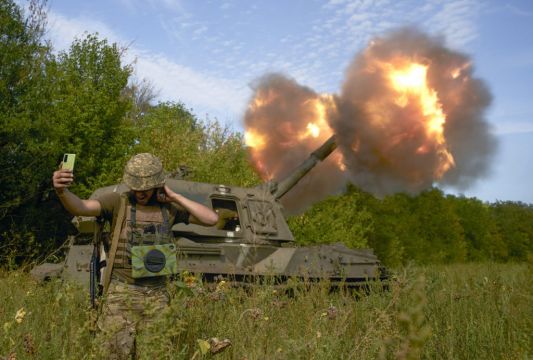Ukrainian forces have pushed their counter-offensive in the country’s east – exploiting quick gains they made in a week of fighting that has sharply changed the course of the conflict.
Ukraine’s quick action to reclaim Russia-occupied areas in the north-eastern Kharkiv region forced Moscow to withdraw its troops to prevent them from being surrounded and leave behind significant numbers of weapons and munitions in a hasty retreat.
It came as the war marked 200 days on Sunday.
Latest Defence Intelligence update on the situation in Ukraine - 11 September 2022
Find out more about the UK government's response: https://t.co/XE7QGQnZeh
🇺🇦 #StandWithUkraine 🇺🇦 pic.twitter.com/88KnwEqDNj— Ministry of Defence 🇬🇧 (@DefenceHQ) September 11, 2022
Advertisement
The jubilant Ukrainian President Volodymyr Zelensky mocked the Russians in a video address late on Saturday, saying “the Russian army in these days is demonstrating the best that it can do — showing its back.”
On Sunday, he posted a video of Ukrainian soldiers hoisting the national flag over Chkalovske, another town they reclaimed from the Russians in the counter-offensive.
Britain’s Ministry of Defence said on Twitter on Sunday: “Over the last 24 hours, Ukrainian forces have continued to make significant gains in the Kharkiv region. Russia has likely withdrawn units from the area, but fighting continues around the strategically important cities of Kupiansk and Izium.
“On 07 September 2022, President Putin said that only 60,000 tonnes of the grain exported from Ukraine since August had been sent to developing countries, and that the majority had been delivered to EU states.
“Putin’s claim is not true. According to UN figures, around 30% has been supplied to low and middle-income countries in Africa, the Middle East and Asia.
“Russia is pursuing a deliberate misinformation strategy as it seeks to deflect blame for food insecurity issues, discredit Ukraine and minimise opposition to its invasion.”
Ukraine’s military chief, General Valerii Zaluzhnyy, said Ukraine has liberated about about 1,160 square miles since the beginning of September.
He said Ukrainian troops are now about 30 miles away from the border with Russia.
The Russians’ pullback marked the biggest battlefield success for Ukrainian forces since they thwarted a Russian attempt to seize the capital, Kyiv, at the start of the nearly seven-month war.
Ukraine’s attack in the Kharkiv region came as a surprise for Moscow, which had relocated many of its troops from the area to the south in expectation of the main Ukrainian counter-offensive there.

In an awkward attempt to save face, the Russian Defence Ministry said on Saturday the troops’ withdrawal from Izyum and other areas in the Kharkiv region was intended to strengthen Russian forces in the neighbouring Donetsk region to the south.
The claim sounded similar to the justification Russia gave for pulling back its forces from the Kyiv region earlier this year when they failed to take the capital.
The group of Russian forces around Izyum has been key for Moscow’s effort to capture the Donetsk region, and their pullback will now dramatically weaken the Russian capability to press its offensive to Ukrainian strongholds of Sloviansk and Kramatorsk just to the south.
Igor Strelkov, who led Russia-backed separatists in the early months of the conflict in the Donbas when it erupted in 2014, mocked the Russian Defence Ministry’s explanation of the retreat, suggesting that handing over Russia’s own territory near the border to Ukraine as a “contribution to Ukrainian settlement”.
The retreat drew angry comments from Russian military bloggers and nationalist commentators, who bemoaned it as a major defeat and urged the Kremlin to respond by stepping up war efforts.
Many scathingly criticised Russian authorities for continuing with fireworks and other lavish festivities in Moscow that marked a city holiday on Saturday despite the debacle in Ukraine.
Just as the Russian forces were hastily pulling back from Izyum under Ukrainian fire, Russian President Vladimir Putin attended the opening of a huge observation wheel at a Moscow park, a new transport link and a sports arena.
The action underlined the Kremlin’s effort to keep pretending that the war it calls a “special military operation” was going according to plan without affecting the situation in the country.
Pro-Kremlin political analyst Sergei Markov criticised the festivities in Moscow as a grave political mistake.
“The fireworks in Moscow on a tragic day of Russia’s military defeat will have extremely serious political consequences,” Mr Markov wrote on his messaging app channel.
“Authorities mustn’t celebrate when people are mourning.”
In a sign of potential rift in the Russian leadership, Ramzan Kadyrov, the Kremlin-backed leader of Chechnya, said the retreat from the Kharkiv region resulted from the Russian military leadership’s blunders.

“They have made mistakes and I think they will draw the necessary conclusions,” Mr Kadyrov said.
“If they don’t make changes in the strategy of conducting the special military operation in the next day or two, I will be forced to contact the leadership of the Defence Ministry and the leadership of the country to explain the real situation on the ground.
Ukrainian defence minister Oleksii Reznikov said in televised comments on Saturday the Russians have been cut off from supply lines, and predicted more gains.
“It will be like an avalanche,” he said, predicting a Russian fallback. “One line of defence will shake, and it will fall.”
Despite Ukraine’s gains, US secretary of state Antony Blinken and the head of Nato warned on Friday the war would likely drag on for months.
Mr Blinken said the conflict was entering a critical period and urged Ukraine’s Western backers to keep up their support through what could be a difficult winter.
In another major development on Sunday, the Zaporizhzhia nuclear power plant, Europe’s largest, was reconnected to Ukraine’s electricity grid, allowing engineers to shut down its last operational reactor in an attempt to avoid a radiation disaster as fighting rages in the area.
For several previous days, the plant was operating in “island mode”, with just one of its six-reactors working to power cooling systems and other crucial equipment.







